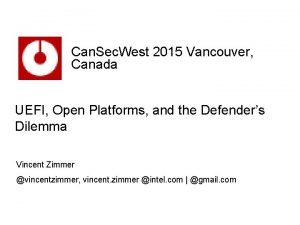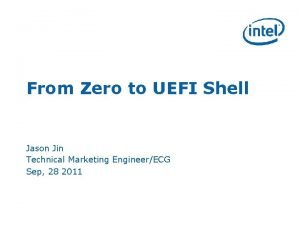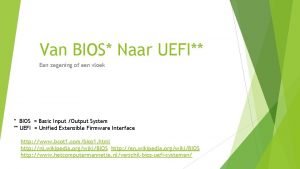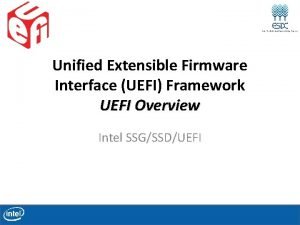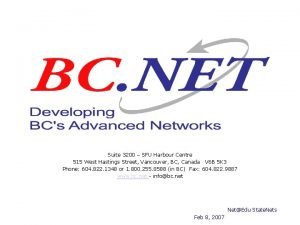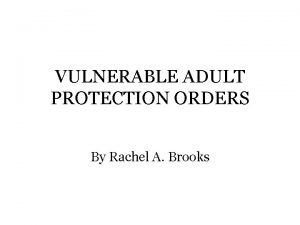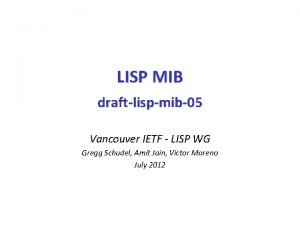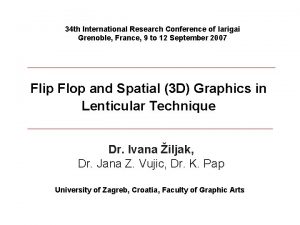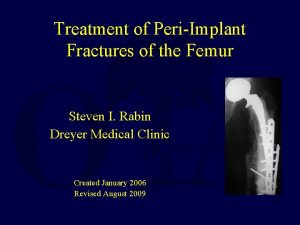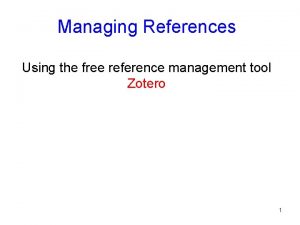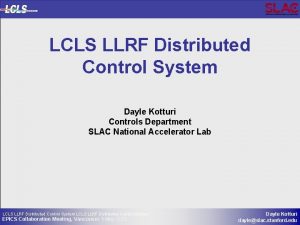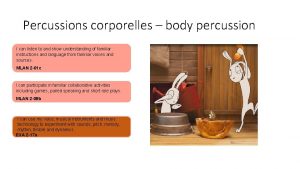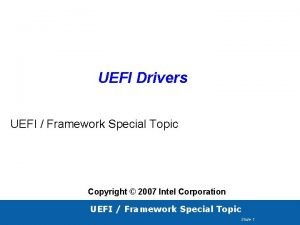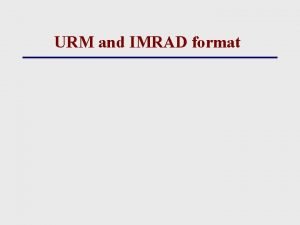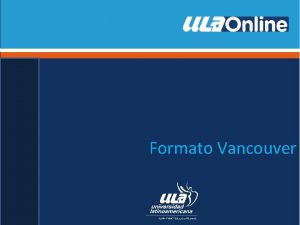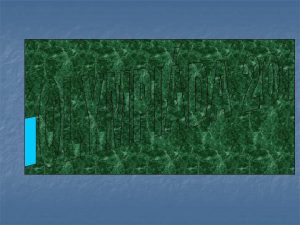Can Sec West 2015 Vancouver Canada UEFI Open














![UEFI [Compliant] Firmware CPU Reset SEC S-CRTM; Init caches/MTRRs; Cache-as-RAM (NEM); Recovery; TPM Init UEFI [Compliant] Firmware CPU Reset SEC S-CRTM; Init caches/MTRRs; Cache-as-RAM (NEM); Recovery; TPM Init](https://slidetodoc.com/presentation_image_h/319cb8bc730ab4ecf172e2503a0c11be/image-15.jpg)




























![Security Data CP/M (1974) IBM PC (1981) PC (1999) Malware [1949]: John von Neumann Security Data CP/M (1974) IBM PC (1981) PC (1999) Malware [1949]: John von Neumann](https://slidetodoc.com/presentation_image_h/319cb8bc730ab4ecf172e2503a0c11be/image-44.jpg)




































- Slides: 80

Can. Sec. West 2015 Vancouver, Canada UEFI, Open Platforms, and the Defender’s Dilemma Vincent Zimmer @vincentzimmer, vincent. zimmer @intel. com | @gmail. com

Agenda • Background on UEFI • Security Features • Trust Model • EDK II on Minnow. Max • EDK II on Galileo • Futures

Background on UEFI

Old Day Machine 19 XX

Pioneer CP/M BIOS (machine specific CP/M) 8080/Z 80 1974 Basic I/O (Sub) System by Gary Kildall in CP/M

PC/AT BIOS DOS BIOS (de facto standard) 8088 1981 IBM PC

PC/AT BIOS -> EFI IPF Windows/Linux EFI (Intel Standard) IPF (Merced) 2000 Extensible Firmware Interface Intel/HP IPF

Broader adoption Windows/Linux UEFI (Industry Standard) IA 32/X 64/IPF/ARM 2006 January Unified Extensible Firmware Interface

Today Windows/Linux UEFI Generic UEFI Platform • • • Drivers DXE Drivers PI CPU Module • • • Silicon Module IA 32/X 64/IPF/ARM 2006 Aug Platform Initialization UEFI + PI

Industry Transition Pre-2000 All Platforms BIOS were proprietary 2000 Intel invented the Extensible Firmware Interface (EFI) and provided sample implementation under free BSD terms 2004 tianocore. org, open source EFI community launched 2005 Unified EFI (UEFI) Industry forum, with 11 members, was formed to standardize EFI 2015 240 members and growing! Major MNCs shipping; UEFI platforms crossed most of IA worldwide units; Microsoft* UEFI x 64 support in Server 2008, Vista* and Win 7*; Red. Hat* and Su. SEl* OS support. Mandatory for Windows 8 client. ARM 32 and 64 bit support. ACPI added.

What is UEFI? UEFI Platform Initialization Overview Human User OS (UEFI or Today’s) Pre-boot Tools UEFI PI Scope - Green “H” UEFI Specification Platform Drivers Silicon Component Modules Hardware PEI/DXE PI Foundation Modular components GUI Application Libraries Drivers Network OS Firmware Hardware Full system stack (user -> hardware) UEFI 2. 4 specifies how firmware boots OS loader UEFI’s Platform Initialization (PI) 1. 3 Architecture specifies how Driver Execution Environment (DXE) Drivers and Pre-EFI Initialization (PEI) Modules (PEIMs) initialize SI and the platform DXE is preferred UEFI Implementation PEIMs, UEFI and DXE drivers implement networking, Update, other security features

Where are we (UEFI firmware)? VM App App OS BIOS & OS/VMM share access, but not trust UEFI + PI SMM Privilege VMM / Hypervisor SMM / BIOS Hypervisor can grant VM direct hardware access CPU Peripherals Memory Firmware Hardware Platform DMA A specific Peripheral may have its own processor, and its own firmware, which is undetectable by host CPU/OS.

What’s in UEFI

Startup Tem p. Ra m PEI Core UEFI Interfaces Boundary for PM_AUTH/ End. Of. Dxe Event UEFI Shell Device, Bus, or Service Driver CPU Init Chipset Init Board Init Transient OS Boot Loader Architectural Protocols Power on Driver Execution Environment (DXE) Boot Dev Select (BDS) [. . Platform initialization. . ] OEM/PM extensible OS-Present App Boot Manager EFI Driver Dispatcher Security Pre EFI (SEC) Initialization (PEI) OS-Absent App Final OS Boot Loader Final OS Environment Transient System Load Run Time (TSL) (RT) [. . OS boot. . ] 3 rd party extensible Overall UEFI Boot Timeline Shutdown
![UEFI Compliant Firmware CPU Reset SEC SCRTM Init cachesMTRRs CacheasRAM NEM Recovery TPM Init UEFI [Compliant] Firmware CPU Reset SEC S-CRTM; Init caches/MTRRs; Cache-as-RAM (NEM); Recovery; TPM Init](https://slidetodoc.com/presentation_image_h/319cb8bc730ab4ecf172e2503a0c11be/image-15.jpg)
UEFI [Compliant] Firmware CPU Reset SEC S-CRTM; Init caches/MTRRs; Cache-as-RAM (NEM); Recovery; TPM Init Pre-EFI Init (PEI) S-CRTM: Measure DXE/BDS Early CPU/PCH Init Memory (DIMMs, DRAM) Init, SMM Init Driver Exec Env (DXE) ACPI, UEFI System. Table, SMBIOS table Continue initialization of platform & devices Enum FV, dispatch drivers (network, I/O, service. . ) Produce Boot and Runtime Services Boot Dev Select (BDS) Exit. Boot. Services. Minimal UEFI services (Variable) Boot Manager (Select Boot Device) EFI Shell/Apps; OS Boot Loader(s) Runtime / OS

Implementation Specifications Specification & Tianocore. org Timeline http: //uefi. org UEFI 2. 0 UEFI 2. 1 UEFI 2. 2 PI 1. 0 UEFI 2. 3 PI 1. 1 UEFI 2. 3. 1 UEFI 2. 4 PI 1. 2 Shell 2. 0 PI 1. 3 Packaging 1. 0 ACPI 5. 1 2006 2007 2008 SCT UEFI 2. 0 EDK 1. 01: UEFI 2. 0 2009 2010 SCT UEFI 2. 1 SCT UEFI 2. 3 EDK 1. 04: UEFI 2. 1 EDK 1. 06: UEFI 2. 1+ PI 1. 0 SCT PI 1. 0 EDK II*: UEFI 2. 1+ UDK 2010: UEFI 2. 3 PI 1. 0 PI 1. 2 http: //tianocore. org Source. Forge. net All products, dates, and programs are based on current expectations and subject to change without notice. 2011 -14 FSP 1. 0 UDK 2014 UEFI 2. 4 PI 1. 3

• USWG • UEFI Specification Working Group • PIWG www. uefi. org • Platform Initialization Working Group • ASWG • ACPI Specification Working Group ASWG, PIWG • BOS • Board Of Directors • USST BOD • USWG Security Sub-team USRT • Chaired by Vincent Zimmer (Intel) USWG • Responsible for all security related material and the team that has added security infrastructure in the UEFI spec UNST • USRT • UEFI Security Response Team USST • Chaired by Dick Wilkins (Phoenix) • Provide response to security issues. …… • UNST • UEFI Network Sub-team (VZ chairs, too) Note: Engaged in firmware/boot • Evolve network boot & network security Related WG’s of Trusted Computing Group (TCG), IETF, DMTF infrastructure for UEFI Specification Working Groups in UEFI

UDK 2014 Available on Tianocore. org

How to build it? UDK 2014 Industry Standards Compliance • UEFI 2. 0, UEFI 2. 1, UEFI 2. 2, UEFI 2. 3, UEFI 2. 4; PI 1. 0, PI 1. 1, PI 1. 2, PI 1. 3, ACPI 5. 1 Extensible Foundation for Advanced Capabilities Support for UEFI Packages • Import/export modules source/binaries to many build systems Maximize Re-use of Source Code** • Platform Configuration Database (PCD) provides “knobs” for binaries • ECP provides for reuse of EDK 1117 (EDK I) modules • Improved modularity, library classes and instances • Optimize for size or speed Multiple Development Environments and Tool Chains** • Windows, Linux, OSX • VS 2003, VS 2005, Win. DDK, Intel, GCC Fast and Flexible Build Infrastructure** • 4 X+ Build Performance Improvement (vs EDKI) • Targeted Module Build Flexibility Maximize the open source at www. tianocore. org Intel® UEFI Development Kit 2010 (Intel® UDK 2010) ** benefit of EDK II codebase • Pre-OS Security • Rich Networking • Manageability

Contents Time USB 1. 1 USB 2 Since ~2001 PCIe ACPI 2 UEFI 2. 0 USB 3 ACPI 3 UEFI 2. 1 ACPI 4 UEFI 2. 2 PI 1. 0 UEFI 2. 3 PI 1. 1 EDK I ACPI 5. 1 UEFI 2. 4 PI 1. 2 ECP Hundreds deep Today Sustaining 20 New dev

Core evolution 1. 4 1. 1 1. 3 1. 2 3. 1 Trunk 1. 0 2. 0 3. 0 2. 1 3. 2 3. 3 4. 0 2. 2 2. 3 Time Different branches to support 21

The road from core to platform tianocore. org Open Source Reference Tree OEM BIOS Op e urc So en New product Existing product End users updating? Commercial product in the field Consumer product in the field IBV All Intel OEM IBV ODMs updating? ODM BIOS Existing ODM product Time New product

Security Features

Solving Firmware Update • Reliable update story • • Fault tolerant Scalable & repeatable • How can UEFI Help? • • • Capsule model for binary delivery Bus / Device Enumeration Managing updates via • • • EFI System Resource Table Firmware Management Protocol Capsule Signing

Delivering Firmware Binaries • UEFI supports Capsule format • • Tools for capsule generation Core logic for capsule handling • Extensible Capsule format • • • Self-contained Discrete updates Composite updates • Firmware Management Protocol allows • • Reading / updating firmware Integrity checks

Rollbacks with fences Version 1 Version 2 Version 3 “Fence” Each version fixes some issues with the previous. Since none are known to have security flaws, each new version allows updates to all older versions. Version 4 In V 4, one of the issues fixed in V 3 is realized to be a security fix. V 4 will not allow updates to earlier versions, even V 3 since it allows update to V 2. Version 4 Version 5 can now accept only versions 5 and 4.

Security Solutions • Signed capsule updates • UEFI Secure boot • • local / network TPM on the platform • • • Measured boot Root of Trust for Reporting Storage • Protect machine configuration & UEFI Secure boot trust anchors • In-band out-of-band network security

Guarding & Verifying in Pre-boot • PI & UEFI complement each other to impart platform security through guarding and verification during pre-boot. • PI facilitates platform hardening by guarding internal firmware ingredients that consume reset vector, initialization of CPU, Memory, Chipset etc. • UEFI signing allows robust platform scaling through verified inclusion of external firmware ingredients such as OPROMS into the trust chain

UEFI Driver Signing Why? – Origin & Integrity How? – Authenticode PE PKCS#7 + Authenticode Ext PE Image Content. Info PE Header PE file hash Certificate Directory Certificate Section 1 …… X. 509 Certificate Section N Type Attribute Certificate Table Sign. Info Signed hash of Content. Info

UEFI Authenticated Variable Why? – Integrity (no confidentiality) How? – Time Based Authenticated Variable Input Variable Data Authentication Time Stamp Content. Info PKCS#7 N/A Certificate X. 509 Certificate Type Certificate Data Content Sign. Info Signed hash of Variable. Name + Variable. Guid+ Attributes + Time. Stamp + Data. Content

Put them altogether: UEFI Secure Boot

UEFI Secure Boot VS Boot Kernel Drivers • UEFI Secure boot will stop platform boot if signature not valid (OEM to provide remediation capability) • UEFI will require remediation mechanisms if boot fails record in PCR UEFI OS Ldr, Drivers UEFI PI will measure OS loader & UEFI drivers into TPM (1. 2 or 2. 0) PCR (Platform Configuration Register) FI Check signature of before loading UEFI Firmware UE UEFI authenticate OS loader (pub key and policy) TCG Trusted TPM Apps • TCG Trusted boot will never fail • Incumbent upon other SW to make security decision using attestation

PEI FV 1. Enroll Authenticated Variables PK KEK 3. Post ship update DB 2 B. Signature Verification 2 C. Signed Image Load & Measure to TPM db Certificate dbx Certificate Op. Rom. efi Certificate + Sign. Info 2 A. Signed Image Discover Variable Os. Loader. efi DXE FV Certificate + Sign. Info Image Verify UEFI Secure Boot Ceremony. Ellison, Carl M. “Ceremony Design and Analysis, ” IACR Cryptology e. Print Archive (2007): 399. https: //eprint. iacr. org/2007/399. pdf

Relevant open source software packages/routines for Authorization flow See Rosenbaum, Zimmer, "A Tour Beyond BIOS into UEFI Secure Boot, “ for more details

Load the UEFI image as long as it is trusted Linux Update – Multiple OS Boot with MOK

Either the UEFI CA key or SUSE key will let the shim boot with UEFI secure boot Multi-Signature Support for Shim

Random. Number. Generator UEFI driver implementing the EFI_RNG_PROTOCOL from the UEFI 2. 4 specification TCG PEI Modules & DXE drivers implementing Trusted Computing Group measured boot EFI_TCG_PROTOCOL and EFI_TREE_PROTOCOL from the TCG and Microsoft MSDN websites, respectively User. Identification DXE drivers that support multi-factor user authentication Chapter 31 of the UEFI 2. 4 specification Library Dxe. Verification. Lib for “UEFI Secure Boot”, chapter 27. 2 of the UEFI 2. 4 specification + other support libs Variable. Authenticated SMM and runtime DXE authenticated variable driver, chapter 7 of the UEFI 2. 4 specification https: //svn. code. sf. net/p/edk 2/code/trunk/edk 2/Security. Pkg UDK 2014 Security. Pkg

Variable Lock Protocol Make variables read-only https: //github. com/tianocore/edk 2/blob/master/Mde. Module. Pkg/Include/Protocol/Variable. Lock. h Lock Box Protect content across re-starts https: //github. com/tianocore/edk 2 -Mde. Module. Pkg/blob/master/Include/Protocol/Lock. Box. h Capsule Update Generic capsule update driver support http: //comments. gmane. org/gmane. comp. bios. tianocore. devel/8402 https: //svn. code. sf. net/p/edk 2/code/trunk/edk 2/ Additional capabilities in the open source

Analyze and Mark external Interfaces where input can be attacker controlled data, comment headers /** Install child handles if the Handle supports GPT partition structure. Caution: This function may receive untrusted input. The GPT partition table is external input, so this routine will do basic validation for GPT partition table before install child handle for each GPT partition. @param[in] This Calling context. @param[in] Handle Parent Handle. @param[in] Device. Path Parent Device Path. **/ EFI_STATUS Partition. Install. Gpt. Child. Handl UDK 2010 example: http: //edk 2. svn. sourceforge. net/svnroot/edk 2/trunk/edk 2/Mde. Module. Pkg/Universal/Disk/Partition. Dxe/Gpt. c Code Management

BIOS DXE/UEFI Start Block PEI CPU/SOC (Intel) (OEM) Intel Boot Guard (OSV) Executable Enforces OS Loader/Kernel Enforces Executable Enforces Policy Engine Policy Intel® Device Protection Technology with Boot Guard http: //www. intel. com/content/dam/www/public/us/en/do cuments/product-briefs/4 th-gen-core-family-mobilebrief. pdf OEM PI Verification Using PI Signed Firmware Volumes Vol 3, section 3. 2. 1. 1 of PI 1. 3 Specification OEM UEFI 2. 4 Secure Boot Chapter 27. 2 of The UEFI 2. 4 Specification Intel® Boot Guard

Technologies – putting it together Reset Assets TCG Measurements into PCRs 0. . 7 BIOS Flash System BIOS NIST SP 800 -147. PEI recovery. DXE SMM, UEFI Core Option ROMs BIOS device drivers Network Boot IPv 6 for the cloud OS Boot loader Threats ROM Swap Bit rot Erase flash part Overwrite flash part Erase op ROM Overwrite op ROM Network attacks Spoof boot loader BIOS loads the OS To BIOS, VM is an OS Different colors for different vendors H/W Spec SP 800 -147 UEFI 2. 4

Trust Model

System Data CP/M (1974) IBM PC (1981) PC (1999) PC (2012) BIOS ROM <4 K 40 K 512 K 4 M Processor 8080 8088 Pentium III Ivy Bridge OS CP/M DOS Win 98 Win 8
![Security Data CPM 1974 IBM PC 1981 PC 1999 Malware 1949 John von Neumann Security Data CP/M (1974) IBM PC (1981) PC (1999) Malware [1949]: John von Neumann](https://slidetodoc.com/presentation_image_h/319cb8bc730ab4ecf172e2503a0c11be/image-44.jpg)
Security Data CP/M (1974) IBM PC (1981) PC (1999) Malware [1949]: John von Neumann - Theory of self-reproducing automata [1971]: Bob Tomas: Creeper “I’m Creeper: Catch me If you Can” [1984]: Fred [1999]: CIH Cohen- (Intel 430 TX) Computer Viruses - Theory and Experiments (VAX, UNIVAC) [1986]: Farooq Alvi – Brian (IBM PC) Security Bios Password [1972] Anderson - Computer Security Technology Planning [1973] Bell-La. Padula [1977] Biba Integrity [1989] Clark Wilson PC (2012) [2011]: BMW /Mebromi (Award BIOS) *[2005~] Boot. Kit *[2006~] Bios. Rootkit *[2006~] SMM *[2008] Password *[2008~] NIC *[2009] BMP *[2009] ME *[2009~] KBC/EC *[2011] Battery Bootkit S 3 SMM Flash Protection [2003] TCG [1992] SMM in [2006] TXT i 486 SL [2006] UEFI Secure Boot [2009] SMRR [2014] Intel ® Boot and BIOS Guard

Security Challenges • Different elements in platform from many vendors • How to establish trust anchor in the hardware • How to protect elements • How to protect the platform • How to allow platform scaling

BIOS Potential Attack Surfaces Unsafe Coding Practices Server Mgmnt Interfaces BIOS Update Interfaces Shell Apps & Diags Option ROMs Standard APIs BIOS Vendor Hooks System Mgmnt Mode

BIOS Malware Bootkits UEFI Rootkits SMM Rootkits Device FW Malware ACPI Rootkits Option ROM Malware Evil Maid HVM Rootkits (Blue Pill) HW Trojans Pre-Boot Threats

Missed a Detail Source: Jeff Forristal

Security Fundamentals

Security Fundamentals

What Could Possibly Go Wrong? ? ? SMM Intrinsic Services verify Pre Verifier UEFI Runtime, ACPI, SMBIOS, …. CPU Init Chipset Init Board Init SMM IPL Device, Bus, or Service Driver EFI Driver Dispatcher Power on Transient OS Boot Loader OS-Present App Boot Manager Pre EFI Driver Execution Boot Dev Initialization Environment Select (PEI) (DXE) (BDS) [. . Platform initialization. . ] OS Absent Application Exposed Platform Interface Boot Services Runtime Services security Security (SEC) SMM Handler Final OS Boot Loader Final OS Environment ? Transient System Load (TSL) Run Time (RT) After Life (AL) [. . OS boot. . ] Shutdown

Things need consider System Protect Firmware c e R o r ve Detect

What to build & defend – Rationale for a threat model “My house is secure” is almost meaningless § Against a burglar? Against a meteor strike? A thermonuclear device? “My system is secure” is almost meaningless § Against what? To what extent? Threat modeling is a process to define the goals and constraints of a (software) security solution § Translate user requirements to security requirements We used threat modeling for our UEFI / PI codebase § We believe the process and findings are applicable to driver implementations as well as UEFI implementations in general

Defining, using a threat model A Threat Model (TM) defines the security assertions and constraints for a product § Assets: What we’re protecting § Threats: What we’re protecting it against § Mitigations: How we’re protecting our Assets Use TM to narrow subsequent mitigation efforts § Don’t secure review, fuzz test all interfaces § Select the ones that are critical TM is part science, part art, part experience, part nuance, part preference § Few big assets vs lots of focused assets

We don’t always get to choose our Assets Boot flow SMM Operating System Security “Researcher s” PE/COFF Build tools Option ROM Source BIOS Flash Internal Research S 3 S 0 NIS T This reg That reg Other bit UEFI, TCG, OSV Internal Research

Flash** NIST SP 800 -147 says § Lock code flash except for update before Exit Mfg Auth § Signed update (>= RSA 2048, SHA 256) § High quality signing servers § Without back doors (“non-bypassability”) Threats § PDOS – Permanent Denial of Service § § System into inefficient room heater Elevation of privilege § Owning the system at boot is an advantage to a virus Known attacks § CIH / Chernobyl 1999 -2000 § Mebroni 2010 Mitigations include § Reexamining flash protection methods – use the best even if its new § Using advanced techniques to locate and remove (un)intentional backdoors ** or tomorrow’s equivalent NV storage

SMM is valuable because § It’s invisible to Anti Virus, etc § SMM sees all of system RAM § Not too different from PCI adapter device firmware Threats § Elevation § View secrets or own the system by subverting RAM Known attacks § See e. g Duflot, Legbacore Mitigations include § Validate “external” / “untrusted” input § Remove calls from inside SMM to outside SMM

Resume from S 3 This reg That reg Other bit ACPI says that we return the system to the S 5 S 0 configuration at S 3 S 0 § Must protect the data structures we record the cold boot config in Threats § Changing data structures could cause security settings to be incorrectly configured leaving S 3 § Reopen the other assets’ mitigated threats Known attacks Mitigations include § Store data in SMM -or§ Store hash of data structures and refuse to resume if the hashes don’t compare

Tool chain Tools create the resulting firmware § Rely on third party tools and home grown tools § Incorrect or attacked tools leave vulnerabilities Threats § Disabled signing, for example Known attacks § See e. g. Reflections on Trust, Ken Thompson** Mitigation § Difficult: For most tools, provided as source code § Review for correct implementation § Use static, dynamic code analysis tools § Py. Lint for Python, for example ** CACM, Vol 27, No 8, Aug, 1984, pp. 761 -763

Boot flow PE/ COFF Secure boot § Authenticated variables § Based on the fundamental Crypto being correct § Correct location for config data Threats § Run unauthorized op roms, boot loaders § PDOS systems with bad config variables Known attacks Mitigations include § Sanity check config vars before use, use defaults § Reviews, fuzz checking, third party reviews, etc.

TM to Modules: Boot flow Var Svcs Authenticated Variables boot control variables Setup Variables Auth Var Svcs PE/Coff Loader Crypto File System USB Stack ATAPI Stack SCSI Stack LAN Stack USB Dev ATAPI Dev SCSI Dev LAN NIC Buff o’flow to pwn sys. Sanity check config pkts. Classic net attacks Fuzz test packets

Assets or not? Variable content sanity checking? ? § If you randomly fill in your Setup variables, will your system still boot? § Fit in as a part of boot flow ACPI? We create it but don’t protect it TPM support? We fill in the PCRs but don’t use them (today) Quality ≠ Security

Vulnerability VS Threat Vulnerability Cases: • Unauthorized Firmware Update • Unauthorized 3 rd Party Code • Critical Register Unlocked • • Buffer Overflow Secret Used but not Cleared • Default Passphrase to Access Threat: • S: Spoof user identity • T: Tampering • R: Repudiation • I: Information disclosure • P: Permanent Denial of Service • E: Elevation of privilege • D: Denial of service

EDK II on Minnow. Max

Minnow. Max Open hardware platform Baytrail single or dual core From http: //firmware. intel. com/projects This project focus in on the firmware source code (and binary modules) requried to create the boot firmware image for the Minnow. Board MAX. The UEFI Open Source (EDKII project) packages for Minnow. Board MAX are available at http: //tianocore. sourceforge. net/wiki/EDK 2. To learn more about getting involved in the UEFI EDKII project visit the How to Contribute page. The source code builds using Microsoft Visual Studios and GNU C Compiler (for both 32 and 64 bit images) - production and debug execution environments. The source code builds the same UEFI firmware image shipping on Minnow. Board MAX. - See more at: http: //firmware. intel. com/projects#sthash. 1 o. Oc 8 sr. Y. dpuf

Intel® Firmware Support Package (FSP) Overview The Intel ® FSP provides processor & chipset initialization in a format that can easily be incorporated into many existing boot loader frameworks without exposing the Intellectual Property (IP) of Intel. § Distributed as single binary § Silicon PEIMs packaged into FSP § Plugs into existing f/w frameworks § Binary customization More information at www. intel. com/fsp

Intel® FSP Boot Flow Parse Return Data Reset Vector Load Microcode Switch to 32 bit Mode Find FSP Entry Point Jump to FSPinit Boot Loader Platform Init Temp Ram Init Mem Init Compani on Chip Init Processo r Init Notify. Phas e Code FSP Intel® FSP Bus and Device Init Notify. Phase Post. Pci. Enum Boot Device Init Load OS or other payload Notify. Ph ase App Ready. To. Boot

Minnow. Max Focused on the maker community, but…. 64 -bit Intel® Atom. TM E 38 xx Series SOC Has UEFI Secure Boot Built off of live tree Ability to update w/ latest capabilities on http: //www. tianocore. org

EDK II on Galileo

Intel® Quark™ So. C – Hardware Overview • 32 bit Intel® Pentium® ISAclass processor • PCI • USB • I 2 C • Single core

UEFI for Intel® Quark™ So. C First fully open source Intel-based platform Builds on Intel® UDK 2014 packages like Mde. Pkg, Mde. Module. Pkg w/ a 32 -bit build, adding § IA 32 Family. Cpu. Base. Pkg § Quark. Platform. Pkg § Quark. Soc. Pkg Standard build is 1 Mbyte image w/full features § Capsule update, SMM, S 3, PCI, recovery, full UEFI OS support, FAT OS support, UEFI variables

Quark and security Support for I 2 C-attached TPM Hardware Secure Boot option UEFI Secure Boot implementation UEFI Capsule update support w/ hardware verification assist …. . Demonstrates one way to build out UEFI Security Features w/ a full open source platform tree

Futures

Integrity analysis of Pre-OS via Compartments – CW/BIBA Business goals dictate isolation boundaries called compartments (cpts) § Platform Manufacturer wants to protect self from 3 rd party pre-OS and OS/Hv § OS/Hv- protect self from pre-boot extensibility § Idealized isolation boundary is a compartment (cpt)– § Not a thing like process, interface table, handle etc § Security types are actual data types that are used in the cpt. § Eg: Smm_code_t, efi_iface_tbl_data_t in OEM cpt Security analysis checks if something is a compartment § Checking a number of information flow rules § Code and data in compartment have verifiable integrity – Compartment needs storage isolated from other compartments – Compartment needs execution isolation § Compartment transitions have chokepoints and are protected via guards – Interfaces into the compartment for code and data must be validated § Admin model of compartment must be fully specified – Admin tasks must be “minimized” to reduce TCO & chance of bugs § Audit (e. g. , TPM measurements)– All integrity affecting operations must be audited – Availability of audit log is also a requirement 74 UEFI Confidential

75 UEFI Confidential

76 UEFI Confidential

77 UEFI Confidential

Moving Forward More open source examples Test tools complement the SCT, but the community can do more! Continue to evolve development philosophy • “Testing shows the presence, not the absence of bugs” (Dijkstra, 1970) • Better Living Through Tools? (Zimmer, 2013) Getting code coverage closer to 100%? • Early effort using DDT with EDK II, Moving to KLEE (open source) More fuzzers, from custom to public (e. g. , Peach) More Isolation – lots of hardware, esp. that built for OS/Hv. Leverage for platform firmware where it makes sense • Map the CW/BIBA CPT analysis to specs & code • Information flow and analysis • NX, ALSR, Stack Canaries

References 1. UEFI Forum http: //www. uefi. org 2. EFI Developer Kit II http: //www. tianocore. org 3. White papers, training, projects http: //firmware. intel. com 4. CHIPSEC: https: //github. com/chipsec 5. Trianocore security advisories 6. UEFI Forum USRT (security@uefi. org , PGP key) 7. Intel PSIRT (secure@intel. com, PGP key) 8. Books http: //www. apress. com/apressopen UEFI SHELL 9. UEFI Overview UEFI Intel Technology Journal 10. Quark Soc X 1000 Version 1. 1. 0 BIOS https: //downloadcenter. intel. com/download/23197/Intel-Quark-BSP 11. Minnow. Max http: //www. minnowboard. org/meet-minnowboard-max/

Thank You Can. Sec. West 2015
 Uefi sec
Uefi sec Uefi
Uefi 5a88 uefi
5a88 uefi Van bios naar uefi
Van bios naar uefi Uefi (unified extensible firmware interface)
Uefi (unified extensible firmware interface) Geoweb north vancouver
Geoweb north vancouver Grewal v litt
Grewal v litt 515 west hastings street vancouver
515 west hastings street vancouver Power point presentation design west vancouver
Power point presentation design west vancouver 영국 beis
영국 beis Ucw dli number
Ucw dli number Forest vegetation region
Forest vegetation region Why did canada west join confederation
Why did canada west join confederation How to open first metro sec account
How to open first metro sec account West north west wind direction
West north west wind direction What creates wind
What creates wind Zuid oost noord west
Zuid oost noord west East is east and west is west
East is east and west is west Old west vs new west
Old west vs new west Cabarrus canvas
Cabarrus canvas Adult protective services vancouver wa
Adult protective services vancouver wa Harvard vs vancouver
Harvard vs vancouver Advertising vancouver island
Advertising vancouver island Formato vancouver ejemplo
Formato vancouver ejemplo Formato vancouver ejemplo
Formato vancouver ejemplo Normas vancouver ejemplos
Normas vancouver ejemplos Landform regions map of canada
Landform regions map of canada Dnv geoweb property viewer
Dnv geoweb property viewer Crabbing vancouver
Crabbing vancouver Vbbl
Vbbl Como citar nanda en vancouver
Como citar nanda en vancouver Aso firm vancouver
Aso firm vancouver Aso vancouver bunch
Aso vancouver bunch Uq vancouver referencing
Uq vancouver referencing Ubc registered nurse program
Ubc registered nurse program Harvard referencing book example
Harvard referencing book example Vancouver wg
Vancouver wg Hope centre north vancouver
Hope centre north vancouver Vancouver web design meetup
Vancouver web design meetup Vancouver clinic pediatrics
Vancouver clinic pediatrics Houle vancouver island
Houle vancouver island Jobs vancouver
Jobs vancouver Vancouver metoden
Vancouver metoden Anchor point fire vancouver
Anchor point fire vancouver Referncia vancouver
Referncia vancouver Vancouver kester grant college
Vancouver kester grant college Integrative medicine vancouver
Integrative medicine vancouver Types of landforms in canada
Types of landforms in canada Approximate symmetrical balance
Approximate symmetrical balance The value investors club
The value investors club Lenticular printing vancouver
Lenticular printing vancouver Vancouver classification
Vancouver classification Vancouver 2010 olympics
Vancouver 2010 olympics Observed experiential integration
Observed experiential integration Journal of the american medical association
Journal of the american medical association Dr briar sexton
Dr briar sexton Survivorship vancouver
Survivorship vancouver Lemonade day greater vancouver
Lemonade day greater vancouver Vme vancouver
Vme vancouver Vpl historical photos
Vpl historical photos Vpl lynda
Vpl lynda Gec viva vancouver price
Gec viva vancouver price Full indie vancouver
Full indie vancouver Plc timers
Plc timers Open hearts open hands
Open hearts open hands If you can imagine it you can achieve it
If you can imagine it you can achieve it Kinds of comparison
Kinds of comparison If you think you can you can poem
If you think you can you can poem If you cant measure it you cant manage it
If you cant measure it you cant manage it If you can't measure it you can't control it
If you can't measure it you can't control it Can can body percussion
Can can body percussion Arrangement of elements of curriculum
Arrangement of elements of curriculum You can tell harris about it just ____(easily) as i can
You can tell harris about it just ____(easily) as i can Positive comparative superlative
Positive comparative superlative He can speak
He can speak Look at the pictures and complete with can or can't
Look at the pictures and complete with can or can't We re going on a bear hunt song
We re going on a bear hunt song Through you nothing is impossible
Through you nothing is impossible You can t manage what you don t measure
You can t manage what you don t measure Already can or can already
Already can or can already Any fool can write code that a computer can understand
Any fool can write code that a computer can understand
